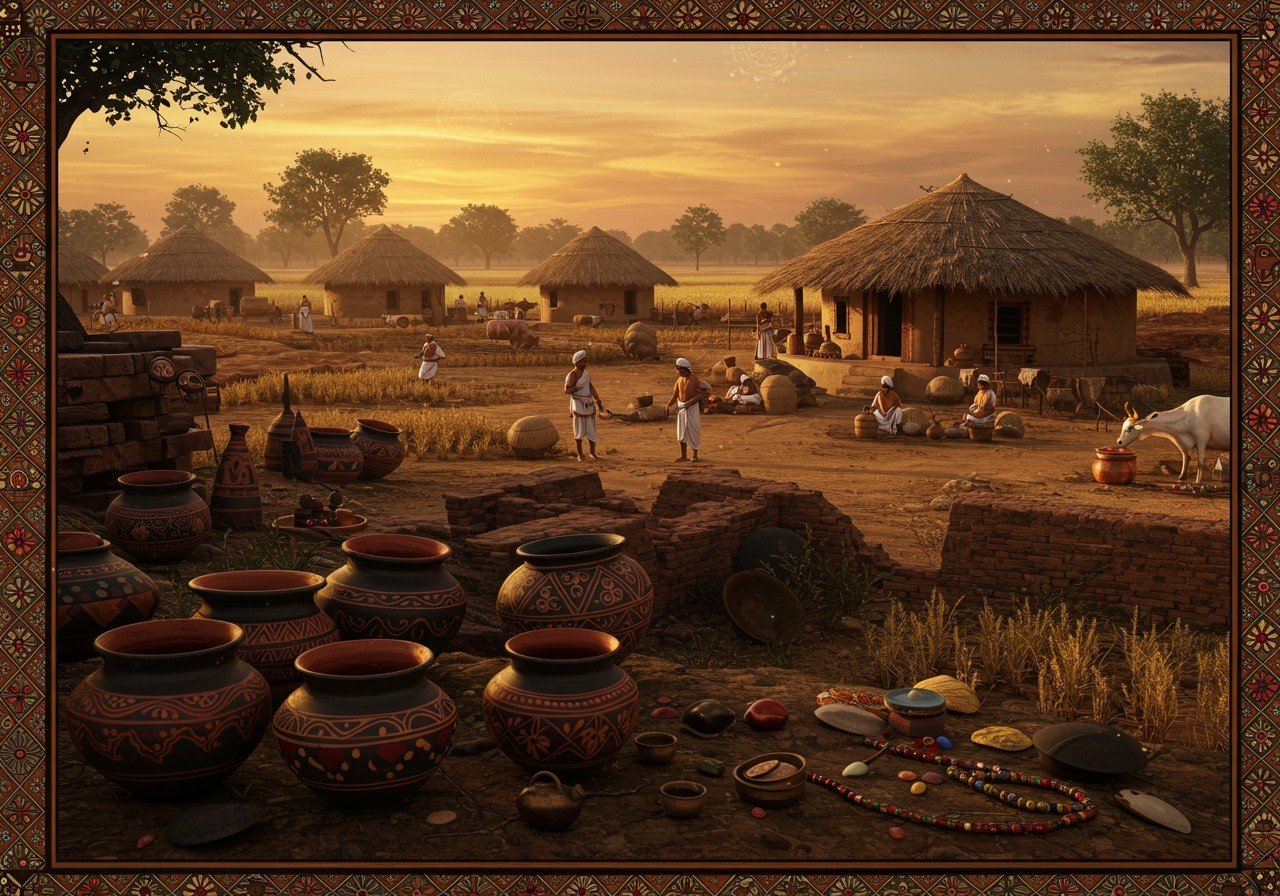
Welcome to the captivating world of the Jorwe Culture, a significant archaeological and historical phenomenon rooted in the Deccan plateau of India. This ancient civilization offers a glimpse into the lives of early agrarian societies and their unique traditions. Join us as we explore the timeline, key characteristics, and lasting contributions of the Jorwe Culture to India’s rich heritage.
Jorwe Culture Overview
The Jorwe Culture, named after the archaeological site of Jorwe in Maharashtra where it was first discovered, thrived during the Chalcolithic period (Copper Age) from around 1500 BCE to 700 BCE. Let’s delve into the key aspects of this fascinating culture:
- Chalcolithic Period: This era marks a crucial transition in technology, characterized by the use of copper alongside stone tools. This development had a profound impact on their daily lives, from agriculture to crafting.
- Geographical Spread: Primarily located in the Deccan plateau region of Maharashtra, western India, and extending into the Malwa region of Madhya Pradesh, the Jorwe Culture occupied a strategic position in ancient India.
- Archaeological Sites: Key sites like Jorwe, Nevasa, and Daimabad have provided invaluable insights into the culture’s material remains, social structures, and daily life.
- Artifacts: Excavations have unearthed a rich array of artifacts, including distinctive painted pottery, tools, ornaments, and evidence of agricultural practices. These findings shed light on their artistic skills, technological advancements, and daily activities.
- Agricultural Practices: The Jorwe people cultivated a variety of crops, including barley, wheat, and pulses. This agricultural proficiency played a vital role in their sustenance and societal development.
- Social Structure: Settlements typically consisted of small villages with a strong emphasis on community-based living. This social structure fostered cooperation and shared resources.
- Burial Practices: Evidence suggests intricate burial rituals and a belief in the afterlife, providing insights into their spiritual beliefs and worldview.
Timeline of Jorwe Culture
Tracing the evolution of the Jorwe Culture over centuries reveals distinct phases:
- Early Phase (1500-1200 BCE): This period witnessed the establishment of initial settlements and the development of agricultural practices, laying the foundation for their society.
- Middle Phase (1200-1000 BCE): A time of expansion and interaction with neighboring cultures, leading to the exchange of ideas and goods.
- Late Phase (1000-700 BCE): The culture experienced a decline attributed to various factors, possibly including climate change and shifts in social dynamics.
Comparing the Jorwe Culture with contemporary cultures in India, such as the Harappan and Malwa cultures, provides a broader understanding of the diverse civilizations that flourished during this period. Significant discoveries from excavations continue to refine our understanding of the Jorwe timeline and the changes in their material culture over time.
Daily Life and Economy in Jorwe Culture
A closer look at the daily life and economic activities of the Jorwe people reveals a resourceful and organized society:
- Farming Techniques: They employed advanced farming techniques, including irrigation and crop rotation, to maximize agricultural output.
- Animal Husbandry: Domestication of animals like cattle, sheep, and goats provided a source of food, milk, and wool.
- Trade Networks: Exchange of goods with neighboring regions fostered economic growth and cultural exchange.
- Craftsmanship: The Jorwe people were skilled in pottery making, creating distinctive red and black painted ware, and metalworking, which played an essential role in their daily lives.
- Dietary Practices: Their diet primarily consisted of cereals, pulses, and dairy products, supplemented by meat from domesticated animals.
- Housing Structures: They lived in simple mud houses with thatched roofs, reflecting their adaptation to the local environment.
- Clothing: Clothing was made from cotton and animal skins, often adorned with beads and ornaments.
Cultural and Religious Practices of Jorwe Culture
The Jorwe Culture provides a captivating glimpse into the spiritual and cultural life of ancient India. They held a deep reverence for nature and their ancestors, which shaped their beliefs and practices.
Religious Beliefs and Practices
The Jorwe community worshipped natural elements like the sun, moon, rivers, and trees, believing these entities possessed divine powers that influenced their lives. Ancestor worship was also a prominent aspect of their belief system, with rituals conducted to honor the spirits of their forebears.
Rituals and Ceremonies
Burial practices in the Jorwe Culture were elaborate, with graves often containing pottery, ornaments, and tools, suggesting a belief in an afterlife where these items would be needed. These customs reflect a structured belief system and respect for the deceased.
Art and Iconography
Pottery stands out as one of the most significant artifacts from Jorwe Culture. Their pottery often featured geometric designs and motifs inspired by nature, offering insights into their artistic expression and symbolic communication.
How Poojn.in Helps You Connect with Ancient Traditions
Poojn.in offers authentic ritual items that help you maintain the sacred connections to ancient traditions like those of the Jorwe culture. Explore our offerings:
- Brass Laddu Gopal Murti: For your home altar or spiritual practices.
- Brass Radha Krishna Murti: Celebrate the divine love of Radha and Krishna.
- Hand-printed Baran Dala Chalon with Puja Accessories: Enhance your puja rituals with traditional items.
Visit Poojn.in to discover a wide selection of ritual items for various spiritual practices. We ensure authenticity and quality, delivering across India.
Conclusion
Exploring the Jorwe Culture is a journey into the heart of ancient Indian heritage. Their connection to nature, reverence for ancestors, and intricate rituals provide a vivid picture of their spiritual and cultural life. By understanding these practices, we gain a deeper appreciation for the richness and complexity of their world.
Andhra Pradesh Coastal Temples
Draksharama Temple Visit


